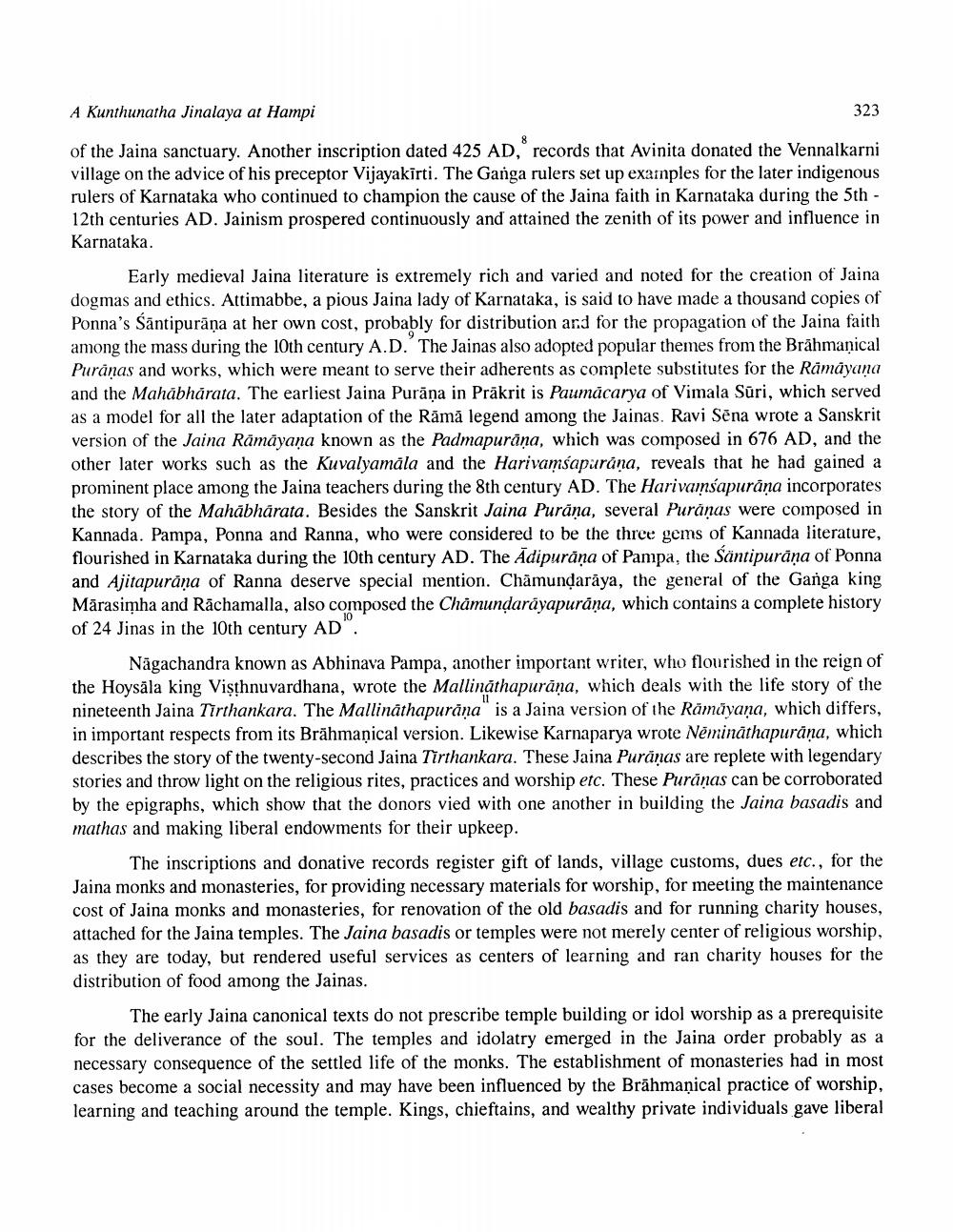________________
A Kunthunatha Jinalaya at Hampi
323
of the Jaina sanctuary. Another inscription dated 425 AD, records that Avinita donated the Vennalkarni village on the advice of his preceptor Vijayakīrti. The Ganga rulers set up examples for the later indigenous rulers of Karnataka who continued to champion the cause of the Jaina faith in Karnataka during the 5th - 12th centuries AD. Jainism prospered continuously and attained the zenith of its power and influence in Karnataka.
Early medieval Jaina literature is extremely rich and varied and noted for the creation of Jaina dogmas and ethics. Attimabbe, a pious Jaina lady of Karnataka, is said to have made a thousand copies of Ponna's Sāntipurāņa at her own cost, probably for distribution and for the propagation of the Jaina faith among the mass during the 10th century A.D. The Jainas also adopted popular themes from the Brāhmanical Puranas and works, which were meant to serve their adherents as complete substitutes for the Rāmāyana and the Mahābhārata. The earliest Jaina Purāņa in Prakrit is Paumăcarya of Vimala Sūri, which served as a model for all the later adaptation of the Rāmā legend among the Jainas. Ravi Sēna wrote a Sanskrit version of the Jaina Rāmāyaṇa known as the Padmapurāņa, which was composed in 676 AD, and the other later works such as the Kuvalyamála and the Harivamsapurana, reveals that he had gained a prominent place among the Jaina teachers during the 8th century AD. The Harivainsapuräna incorporates the story of the Mahabharata. Besides the Sanskrit Jaina Purăņa, several Purăņas were composed in Kannada. Pampa, Ponna and Ranna, who were considered to be the three gems of Kannada literature, flourished in Karnataka during the 10th century AD. The Adipurāņa of Pampa, the Säntipurāņa of Ponna and Ajitapurāņa of Ranna deserve special mention. Chamundarāya, the general of the Ganga king Mārasimha and Rāchamalla, also composed the Chamundarāyapurana, which contains a complete history of 24 Jinas in the 10th century AD.
Nāgachandra known as Abhinava Pampa, another important writer, who flourished in the reign of the Hoysāla king Vishnuvardhana, wrote the Mallināthapurāņa, which deals with the life story of the nineteenth Jaina Tirthankara. The Mallināthapurăņa" is a Jaina version of the Rāmāyaṇa, which differs, in important respects from its Brāhmaṇical version. Likewise Karnaparya wrote Nēmināthapurāņa, which describes the story of the twenty-second Jaina Tirthankara. These Jaina Puräņas are replete with legendary stories and throw light on the religious rites, practices and worship etc. These Purānas can be corroborated by the epigraphs, which show that the donors vied with one another in building the Jaina basadis and mathas and making liberal endowments for their upkeep.
The inscriptions and donative records register gift of lands, village customs, dues etc., for the Jaina monks and monasteries, for providing necessary materials for worship, for meeting the maintenance cost of Jaina monks and monasteries, for renovation of the old basadis and for running charity houses, attached for the Jaina temples. The Jaina basadis or temples were not merely center of religious worship, as they are today, but rendered useful services as centers of learning and ran charity houses for the distribution of food among the Jainas.
The early Jaina canonical texts do not prescribe temple building or idol worship as a prerequisite for the deliverance of the soul. The temples and idolatry emerged in the Jaina order probably as a necessary consequence of the settled life of the monks. The establishment of monasteries had in most cases become a social necessity and may have been influenced by the Brāhmaṇical practice of worship, learning and teaching around the temple. Kings, chieftains, and wealthy private individuals gave liberal




